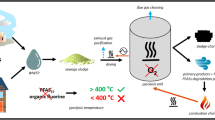Abstract
A substantial amount of sediment phosphorus can be bound in bacterial biomass. In this study the fractional composition of phosphorus in the bacteria Pseudomonas was determined by sequential extraction with ammonium chloride, sodium hydroxide and hydrochloric acid according to the scheme of Hieltjes & Lijklema (1980). Both non-labelled and 32P-labelled bacteria were used for fractionation. Up to 80% of the bacterial phosphorus was found in the NaOH-nRP fraction, which is in agreement with the results of Hupfer & Uhlman (1992) for Acinetobacter and activated sludge obtained with the sequential extraction scheme of Psenner et al. (1985). A significant correlation was found between bacterial biomass and the amount of phosphorus retained in the NaOH-nRP fraction when sediments were fractionated. Additional experiments with 32P-labelled Pseudomonas in sediment-water systems were performed in order to follow bacterial release of phosphorus under aerobic and anaerobic conditions. These studies did not sustain the hypothesis that anaerobic conditions lead to rapid release of phosphorus from bacterial cells.
Similar content being viewed by others
References
Boström, B., I. Ahlgren & R. Bell, 1985. Internal nutrient loading in a shallow eutrophic lake, reflected in seasonal variations of some sediment parameters. Verh. int. Ver. Limnol. 22: 3335–3339.
Boström, B., J. M. Andersen, S. Fleischer & M. Jansson, 1988. Exchange of phosphorus across the sediment-water interface. In G. Persson & M. Jansson (eds), Phosphorus in Freshwater Ecosystems. Developments in Hydrobiology 48. Kluwer Academic Publishers, Dordrecht: 229–244. Reprinted from Hydrobiologia 170.
Boström, B., A-K. Pettersson & I. Ahlgren, 1989. Seasonal dynamics of a cyanobacteria-dominated microbial community in surface sediments of a shallow, eutrophic lake. Aquat. Sci. 51: 153–178.
Bratbak, G. & I. Dundas, 1984. Bacterial dry matter content and biomass estimations. Appl. envir. Microbiol. 48: 755–757.
Einsele, W., 1938. Über chemische und kolloidchemische Vorgänge in Eisen-Phosphat-Systemen unter limnochemischen und limnogeochemischen Gesichtspunkten. Arch. Hydrobiol. 33: 361–387.
Fenchel, T. & T. H. Blackburn, 1979. Bacteria and Mineral Cycling. Academic Press, London.
Fleischer, S., 1983. Microbial phosphorus release during enhanced glycolysis. Naturwissenschaften 70: 415–416.
Fleischer, S., 1985. Microbial mediation of phosphorus exchange at the sediment-water interface. In M. Enell, W. Graneli & L. Hansson (eds), 13th Nordic Symposium on Sediments. pp. 9–16.
Fleischer, S., 1986. Aerobic uptake of Fe(III)-precipitated phosphorus by microorganisms. Arch. Hydrobiol. 107: 269–277.
Fleischer, S., M. Bengtsson & G. Johansson, 1988. Mechanism of the aerobic Fe(III)-P solubilization at the sediment water interface. Verh. int. Ver. Limnol. 23: 1825–1829.
Gächter, R., J. S. Meyer & A. Mares, 1988. Contribution of bacteria to release and fixation of phosphorus in lake sediments. Limnol. Oceanogr. 33: 1542–1558.
Hieltjes, A. H. M. & L. Lijklema, 1980. Fractionation of inorganic phosphates in calcareous sediments. J. envir. Qual. 9: 405–407.
Hupfer, M. & D. Uhlmann, 1992. Phosphate immobilization by microorganisms in lake sediments. Hydrobiologia (in press).
Håkansson, L. & M. Jansson, 1983. Principles of lake sedimentology. Springer, Berlin.
Jansson, M., 1987. Anaerobic dissolution of iron-phosphorus complexes in sediment due to the activity of nitrate-reducing bacteria. Microb. Ecol. 14: 81–89.
Lean, D. R. S., 1973. Phosphorus dynamics in lake water. Science 179: 678–680.
Menzel, D. H. & N. Cordwin, 1965. The measurement of total phosphorus in seawater based on the liberation of organically bound fractions by persulfate oxidation. Limnol. Oceanogr. 10: 280–283.
Mortimer, C. H., 1941. The exchange of dissolved substances between mud and water in lakes. I. J. Ecol. 29: 280–329.
Mortimer, C. H., 1942. The exchange of dissolved substances between mud and water in lakes. II. J. Ecol. 30: 147–201.
Orret, K. & D. M. Karl, 1987. Dissolved organic phosphorus production in surface seawaters. Limnol. Oceanogr. 32: 383–395.
Psenner, R., P. Pucsko & M. Sager, 1985. Die Fraktionierung organischer und anorganischer Phosphorverbindungen von Sedimenten. Arch. Hydrobiol. Suppl. 70: 111–155.
Pettersson, K., B. Boström & O-S. Jacobsen, 1988. Phosphorus in sediment — speciation and analysis. In G. Persson & M. Jansson (eds), Phosphorus in Freshwater Ecosystems. Developments in Hydrobiolgy 48. Kluwer Academic Publishers, Dordrecht: 91–101. Reprinted from Hydrobiologia 170.
Shapiro, J., 1967. Induced rapid release and uptake of phosphate by microorganisms. Science 155: 1269–1271.
Wentzel, M. C., L. H. Lötter, R. E. Loewenthal & G. v. R. Marais, 1986. Metabolic behaviour of Acinetobacter spp. in enhanced biological phosphorus removal — a biochemical model. Water S. A. 12: 209–223.
Author information
Authors and Affiliations
Rights and permissions
About this article
Cite this article
Waara, T., Jansson, M. & Pettersson, K. Phosphorus composition and release in sediment bacteria of the genus Pseudomonas during aerobic and anaerobic conditions. Hydrobiologia 253, 131–140 (1993). https://doi.org/10.1007/BF00050733
Issue Date:
DOI: https://doi.org/10.1007/BF00050733




